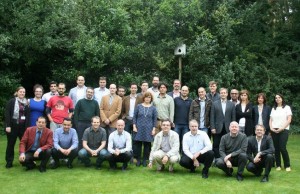New technologies for future high-speed Internet: IHP coordinates project for next-generation mobile communication systems
September 9th, 2015 – Frankfurt (Oder). The next generation of mobile telephony called “5G” will make one thing possible: Internet is always accessible. In 2020, dead spots will be a problem of the past, if researchers are able to implement their ambitious goal worldwide. Scientists of IHP – Innovations for High Performance Microelectronics coordinate the pan-European project “5G-XHaul” which will evaluate the infrastructure to form the next generation of communications networks and services. The project partners include industrial companies, research institutes and universities from four European countries. The goal of the project is to find solutions to the rapidly growing demand for broadband connections, which require new, powerful, cost-effective networks in order to connect the access points.
Which parameters must be improved for networks of the future in order to meet the demand for broadband communication? “Universities and companies work closely together in our project which helps us to clarify such questions. The industry sets the demand. The researchers will find possible solutions. 5G-XHaul will help to ensure that every smart phone owner can rely on an uninterrupted network connection with a high data rate,” said Prof. Eckhard Grass, scientist at IHP.
New powerful cost-effective networks are necessary in order to connect the access points, also called base stations, with the core network of the telecommunication providers. A particular focus of the project will be on establishing dynamically adaptive communication for transport hubs including railway stations and airports and at major events because network connection must be dynamically adapted to the spatial and temporal needs.
“5G-XHaul proposes a converged optical and wireless network solution able to flexibly connect Small Cells to the core network. Exploiting user mobility, our solution allows the dynamic allocation of network resources to predicted and actual hotspots. Due to the dynamic allocation of network resources we can serve the needs of the users.”, Prof. Grass explains.
Field trials are already underway. The Bristol is Open project is a joint venture between the council and university to provide three new fast networks in the centre of Bristol. 5G mmWave company Blu Wireless Technology is trialling its 60 GHz ‘Lightning’ Modules to provide wireless backhaul to the project. Mark Barrett, CMO of Blu Wireless Technology, said of the project, “5G-XHaul is an exciting collaboration set up to establish the ways that networks of the future will operate. For Bristol is Open, Blu Wireless is deploying its mm-Wave technology to extend the fibre network. Millimetre wave wireless technology will form a key aspect of 5G and we are very pleased to be involved in this important project”.
The project “5G XHaul” is part of the 5G Infrastructure Public Private Partnership (5G PPP). This joint initiative of the European information and communications industry and the European Commission will examine the current infrastructure and their limitations and specify requirements for the next generation of communications networks and services. Based on the requirements technical solutions will be investigated and tested. The project “5G XHaul” is funded by the EU program “Horizon 2020” with around 7.3 million euros. It runs over a period of three years, until June 2018.
Partners:
ADVA Optical Networking: www.advaoptical.com
Airrays: www.airrays.com
Blu Wireless Technology: www.bluwirelesstechnology.com
COSMOTE – Mobile Communications S.A.: www.cosmote.gr
i2CAT Foundation: www.i2cat.net/en
IHP – Innovations for High Performance Microelectronics: www.ihp-microelectronics.com
Huawei Technologies Düsseldorf GmbH: www.huawei.eu/research-and-innovation
Telefonica I+D: www.tid.es
TES Electronic Solutions: www.tes-dst.com
TU Dresden: www.tu-dresden.de
University of Bristol: www.bristol.ac.uk
University of Thessaly: www.uth.gr/en
Contact person at IHP, coordinator:
Prof. Eckhard Grass
IHP – Innovations for High Performance Microelectronics
Im Technologiepark 25
15236 Frankfurt (Oder)
Tel: +49 335 5625 717
Fax: +49 335 5625 681
E-Mail: grass(Replace this parenthesis with the @ sign)ihp-microelectronics.com
About IHP:
The IHP is an institute of the Leibniz Association and conducts research and development of sili-con-based systems and ultra high-frequency circuits and technologies including new materials. It develops innovative solutions for application areas such as wireless and broadband communica-tion, aerospace, biotechnology and medicine, automotive industry, security technology and in-dustrial automation. The IHP employs approximately 300 people. It operates a pilot line for tech-nological developments and the preparation of high-speed circuits with 0.13/0.25 μm BiCMOS technologies, located in a 1000 m² class 1 cleanroom.
Participants during the Kick-Off meeting in Bristol © University of Bristol



